11 Best Drawing Toy For Kids of December 2025
List of Top Rated Drawing Toy For Kids from thousands of customer reviews & feedback.
Updated On Dec 2025
1,244 Reviews Studied
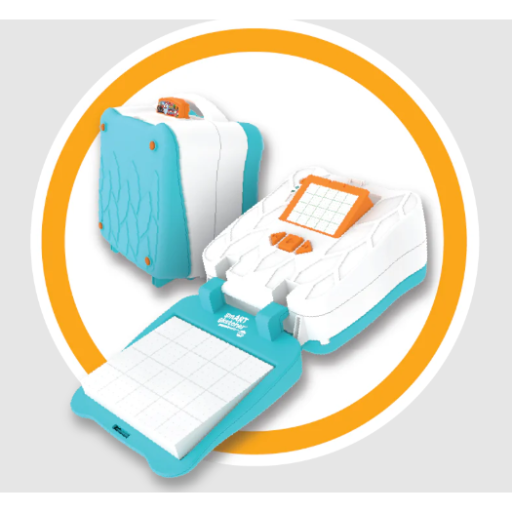
★ Popular Choice
- Compact, portable design for on-the-go creativity.
- Projects images to guide step-by-step drawing.
- Works without a smartphone or tablet for added convenience.
- Includes a USB-C rechargeable battery for long-lasting use.
- Provides pre-loaded educational and creative content.
- Enhances fine motor skills and hand-eye coordination.
- Lightweight and easy for kids to carry anywhere.
- Encourages creativity and storytelling through drawing.
- Durable and kid-friendly design for safe use.
- Perfect for travel, school, or home activities.
$5 OFF COUPON CODE - K2KSKG3TGY
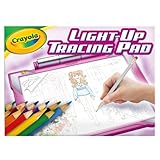
- CRAYOLA LIGHT UP TRACING PAD: Features 1 Tracing Pad, 12 Short Colored Pencils, 10 Tracing Sheets, 10 Blank Sheets, and 1 Graphite Pencil. (3 AA batteries required. Sold separately)
- OVER 100 TRACEABLE IMAGES: Explore more traceable images online to find plenty of inspiration to keep young artists engaged and excited
- LIGHT UP TOY: The light box uses powerful LED light to illuminate images so kids can easily trace and transfer their favorite images
- CONVENIENT DESIGN: The kid friendly, lightweight design features a no-slip frame and uniform lighting for the perfect creative canvas
- HOMESCHOOL SUPPLIES: Reusable, portable, and versatile, this kids' drawing tablet is great for homeschooling by enhancing creativity and learning through art
- EDUCATIONAL TOY FOR KIDS: Explore a variety of art styles including 2D animation, sketching, and expressive lettering
- GIFT FOR GIRLS & BOYS: Give this as a holiday or birthday gift for girls and boys that kids will love
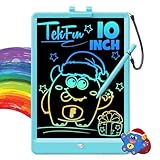
- Free Child’s Imagination: The LCD writing tablet provides 10 inches of space for kid’s writing and drawing, free children's imagination. The eye-protection colorful screen of doodle board provides a better painting experience, avoiding injury to a child’s eyes from long-term use
- No Mess at Home: The built-in battery of the writing tablet doodle board has a 6-month lifespan, provides 100,000 times writing and drawing on the writing tablet, can be replaced and used continuously, and farewell to the traditional painting mode. Avoid paper wasting and no mess at home
- Easy to Use: The drawing tablet uses pressure-sensitive technology, it can create lines with a stylus or any hard object. Click the erase button of the drawing board to clear the screen content in one second, achieve time and energy saving. The key lock effectively prevents accidental clearing, and the screen can be erased when the writing pad unlocking
- Lightweight and Portable: Made of high-quality plastic material, weighs only 150 grams, lightweight and easy to carry, easy to place in travel bags and schoolbags, suitable for multiple occasions: living room, car, plane, restaurant, outdoor places. The writing tablet is waterproof and anti-fall, no need to worry about accidental dropping and liquid pouring on the screen
- Awesome Gift idea: Tekfun multi-functional lcd writing tablet is a perfect gift choice for kids of all age groups. It can be educational toys for preschoolers. It can be a travel toy for long drives and road trips. A parent-pick gift for 3 4 5 6 7 8 year old girls and boys on Easter, back to school, homeschool, birthday, Children's Day, Thanksgiving Day, Christmas and any occasions
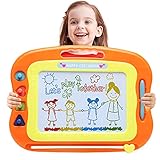
- COLORFUL LARGE DRAWING BOARD: This magnetic drawing board designed with 4 vivid colors(Green, Blue, Yellow, Red) in 8 color zones, making your kids drawings colorful. Bright colors trigger their interest and stimulate curiosity. Toddler toys provides roomy space to allow your kids to fully play with their imagination and creativity
- CHILDREN'S EARLY EDUCATION TOYS: By drawing, writing and playing games to inspire your kid's creativity and imagination in magnetic drawing board. The drawing board contributes to exercising kid's hand-eye coordination, the perception ability and imagination ability
- HIGH QUALITY AND ECO-FRIENDLY: Made of high-quality ABS plastic, the magnetic writing board for kids features smooth edges and soft curves to say goodbye rough, ensuring you relax with a peaceful mind while your child playing,This drawing board is good gift choice,such as valentines day gifts for kids,easter gifts for kids,birthday gifts,christmas gifts,back to school gifts for girls boys
- EASY TO DRAW AND ERASE: Magnetic doodle board features sliding eraser, allowing drawing to be quickly and easily erased. Simply pull the built-in smooth slider across the board to clear the surface, suit for children age of 3 4 5 6 7 year old boy girl
- CUTE STAMPS WITH FUN: With 3 geometrical stamps including a circle, a star and a triangle to add more fun to the magnet drawing board. It can develop your child’s awareness of different shapes. The erasable colorful drawing board pad owns an easy carrying handle that could be hung up on the wall as well

- Package Contents - This extensive arts and crafts set for kids comes with a drawing projector table and a plethora of supplles to spark their imagina tion and nurture their artistic talents. The set includes 12 color drawing pens, 12 colored drawing pencils, 12 colored crayons, 1 drawing book, 1 sticker book, unicorn stickers, unicorn stamps,9 projection discs, and a board eraser.
- Enhanced Drawing Projector for Immersive Learning - The upgraded drawing table, larger than its predecessor, caters comfortably to children. Its versatile switch allows for three modes: projection with sound, projection only, and off.
- Easy Assembly and Engaging Projection - The drawing projector's simple assembly makes it easy for kids to start enjoying it right away. Insert a slide into the projector, adjust the pattern for clarity, and let their creatity flow as they trace the projected patterns.
- Delightful Unicorn Theme and Durable Construction - Designed in an adorable unicorn shape and crafted from high-quality ABS material, this sketch kit is both durable and drop- resistant. It's an ideal gift for 3-year-old girls and makes a wonderful birthday or Christmas present.
- Unwavering Customer Commitment - We are dedicated to providing exceptional customer service. If you encounter any issues with your toddler arts and crafts set, please reach out to us promptly. We will address your concerns within 24 hours. Your purchase is backed by a 1-year warranty.
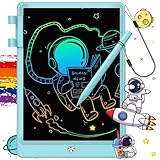
- 👨🚀 [THE BEST KIDS' GIFT & FRIENDLY CUSTOMER SERVICE]: The kids toys is a good educational learning toys, which helps child free their imagination and creativity. It is the best toddler toys for boys girls. Perfect Choice as gift ideas for back to school, birthday, Thanksgiving Day, Easter, Christmas and any occasion. Each kids tablet comes with a writing stylus, so if you have any question about the stylus or doodle board, please directly contact us seller, we will try our best to assist you.
- 👨🚀 [PORTABLE AND LIGHTWEIGHT]: The Preschool toddlers can have all the pleasure, enjoy painting, count the numbers, spell phrases at any time and place (home, car, outside, airplane, school) with no longer making a mess on the ground or walls, especially the time they are at home. 10 inches of writing area, 0.26-inch ultra-thin design, 6 ounces weight, hardly feel the weight of the toys for 5 year old boys, which is convenient to carry with bag.
- 👨🚀 [NO BLUE LIGHT, PROTECT CHILDREN'S EYES, E-CO-FRIENDLY]: FLUESTON LCD writing tablet using highly sensitive pressure sensitive technology and smooth flexible LCD color screen, the lines are colorful, clear and eye-catching. The screen is not self-illuminating, and its optical writing characteristics are the same as papers. No dust, ink, ra-diation, g-lare, safe and hy-gienic, all shield eyes, be safe & comfortable when your kids create work for quite a while.
- 👨🚀 [EASY TO USE, ONE-CLICK CLEAR & SCREEN LOCK]: The writing tablet creates colorful lines of different depth based on how hard you push, just like writing on paper with a pen or pencil! A sensory toys for autistic children is exactly like a bit of paper that can’t be consumed! The magnetic drawing board is built in a CR2025 button battery (hold up to 12 months use, replaceable), which can work quite a while with tens of thousands of erasing! Draw what you want, one button to erase the image.
- 👨🚀 [MULTI-PURPOSE]: A reusable draw pad for kids is suited to writing, drawing, office memo board, message board, and as a communication tool. This type of children’s doodle board is acceptable that you teach your kid to draw or instruction which could present the child’s imagination and enhance imagination by non-polluting, random graffiti, avoiding school-age children’s garments, stocking stuffers for kids. holiday toys list 2022 for 3 3-4 4-5 5+ 6-8 8-10 8-12 10 year old boys girls, easter basket stuffers for kids.

- EYE PROTECTION LCD WRITING TABLET: Adopts 2022 LCD pressure-sensitive technology and 10-inch LCD colorful screen. This toddler doodle board toys without radiation, no glare, safe and comfortable even use for a long time. ENVIRONMENTAL: The battery of the writing and drawing tablet has 3-6 months battery life, can be replaced for cycle use, without charging or plugging in power. The drawing pad toys can provide about 100,000 writings, avoid waste of paper and pencils
- ABSOLUTELY SAFETY TOYS FOR KIDS -- The battery compartment is secured with a screw. Our toddlers are not easy access button battery. Safety for kids. There may be scratches on the screen when opening the package, which is caused by transportation, just press the erase button and the screen will be clear
- EDUCATIONAL LEARNING TOYS WHILE PLAYING: Offers enough space for graffiti and easy viewing, free child’s imagination, provide better preschool or homeschool learning experience!
- ROAD TRIP ESSENTIALS KIDS: The case of drawing board for kids is made of durable plastic, add round corner design which has good shock resistance and drops resistance. The colorful etch a sketch weights only 150 grams and has only 1/ 3 inches thickness, suitable for airplane toys, car activities, travel games accessories.
- MESS FREE COLORING FOR TODDLERS: The doodle baord toys creates colorful lines of different thickness, based on how hard you push with stylus, nails, or any hard thing. Press erase button, emptying the screen content takes only one second. Also can use lock key to save the content. It is recommended to use under light, the line will be brighter.
- 3 4 5 YEAR OLD BOY TOYS: Perfect toys for boys to practice writing and drawing that will keep them entertained. It is dreaming toys that can be handy in the car and useful at home as well. Really useful for growing kids.
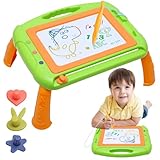
- 【Colorful Toddler Toys Magnetic Drawing Board】 This easter toys for 2 year old drawing board has 4 color areas: red, blue, green and yellow. Colorful erasable doodle board is helpful to educate children to learn color, and cultivate their ability of writing and painting. Doodle board toys for girls can develop children's creative imagination. Besides painting, toddlers easter can exercise arithmetic and writing on the drawing board,funny easter toys for toddlers 1-3
- 【Toddlers Toys for 1 2 3 Year Old Girl Boy】Perfect Easter Gifts For Kids.Magnetic doodle board table with high-quality ABS material. The light writer board for kids with 3 stamps features round edges. The lightweight structure of the drawing board easter presents for kids and its circular edge handle make it easy to carry, and the four legs of the writing board table are solid enough to support the drawing pad. The travel size drawing board is easy for kids to carry everywhere.
- 【Erasable Doodle Board】The drawing pad for kids can be used repeatedly. You only need to gently pull the slide back and forth, and it will be clean again. Extend the life of the toy and let your child love it all the time. The toddler easter gifts toys of this drawing table is 4.9*7.3 inches in drawing area; great size suitable for preschool children to play. 2 year old toys for boys keeps children's hands clean. Magic writing pen with strong string to prevent it from being lost
- 【Toddler Easter Gifts for Kids】The 4 legs of the drawing board table are very easy to assemble and disassemble, just gently insert the corresponding holes, and then it will become a small drawing table learning toys for toddlers 1-3. You can change the form of the magnetic writing board: upright, oblique and flat. Children can choose the most suitable form for their own drawing according to their own needs,perfect kids easter gifts. It helps to develop the correct sitting posture of children
- 【Toddler Toys for Boys Girls Age 2 3 4 5】The toddler boy toys has passed the toy test. It is a toy that 3-year-old children can rest assured of. Magnetic drawing board is great toys for girls age 1 2 3 4 5 6. Little kids toys for 2 year old girl should use under adult's supervision. two year old boy gifts, 3 year old girl gifts, enjoy endless fun for indoor and outdoor travel.festivals gifts, easter gifts for toddlers, birthday gift or visit gift for toddler girl toys. Funny toys for children, kids love it

- CRAYOLA ULTIMATE LIGHT BOARD: Features Crayola Light Up LED Drawing Board with 3 Light Effects Settings, 1 Removeable Tracing Panel, 6 Mini Washable Gel Markers, and 1 Built-In Flip Out Kickstand. (3 AA batteries required - not included).
- LIGHT BOARD: Craft your designs using the 6 special effects gel markers, and illuminate your artwork with 3 dazzling light effects! (Note: Refill your set with Crayola Washable Bold & Bright Markers or Washable Window Markers).
- TRACING PAD: Remove the back panel to use the light board as a light-up tracing pad!
- CONVENIENT DESIGN: This art kit features a built-in kickstand and smart marker storage for tidy travels.
- REUSABLE DRAWING SURFACE: The reusable drawing surface cleans easily with one quick wipe.
- KIDS ART SUPPLIES: The Crayola Ultimate Light Board is a reusable, portable, and versatile kids' drawing tablet for creative art projects.
- HOLIDAY GIFT FOR KIDS: Give the Crayola Light Board as a light up toy and holiday gift for kids ages 6 and up.
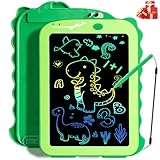
- Multi-functional Kids Toys: The LCD Writing Tablet is an educational learning toy for kids. It exercises your child's writing and drawing skills, inspire kids' creativity, develop concentration, imagination, patience. In addition, babies use tablet to doodle, drawing, spelling, math, notes, writing, playing games, vibrant colors and free creative ways can stimulate interest in art, It can let your kids freely release their natural instincts provides endless entertainment for little artists.
- Learning Educational Toys: Our Eco-Friendly electronic educational writing tablet for kids, boasting a pressure-sensitive LCD screen, Say goodbye to the mess of crayons and pencils. The colorful doodle pad is easy-to-use, just use the stylus to write, draw, scribble, doodle anything you want! Press the erase button to clear the screen in one second, and it features a lock where you can't accidentally delete the screen and some very vibrant colors. It is a fun addition to any toy collection.
- Dinosaur Toys Drawing Tablet: Our 8.5 inch kids drawing tablet adopts the new low-energy consumption eye protection material screen, No Backlight, No Blue Light, No Eye Irritation. Better protect baby's eyesight. The shell and pen is made of safe and durable ABS material, rounded and soft edges, Burr-Free, Non-Toxic, Lead-Free, BPA-free. Every parent absolutely trusts safe and durable toys!
- Toddles Travel Toys: The toddles toys can bring child imaginations and creates to life with ease. The drawing pad lightweight and portable design easy to carry make it perfect for on-the-go entertainment, provides kids with a fun and eco-friendly way to draw, write, and take notes with no mess or cleanup required, and the long-lasting battery life ensures hours of uninterrupted fun. Travel toys for 3 4 5 6 7 8 years old boys or girls.
- Idea for Kids Gift: Writing board toddler toy as a fantastic gift for kids of all ages. Its simplicity, durability, and endless creative possibilities make it a great addition to playtime, In addition, our toys can also reduce children's anxiety and restlessness, so it is a great gift choice for children with autism and ADHD also. Our drawing tablet is a great birthday, Christmas, Thanksgiving gift for boys and girls aged 2-8 years old.
- Easy to Use & One Click Erase: Step 1. Simply press round erase button on the side,all drawings are gone in one sec. Step 2. If you wanna keep the drawings, turn on the lock key on the side to keep the drawings. Step 3. It is more convenient for children to use.you can still erase the drawings after unlocking. WARM TIPS: There may have scratches on the screen when opening package, which is caused by transportation, just press the erase button and the screen will be clear instantly.

- Water Drawing Mat:Large size.Ocean pattern.Be easy to use.Can be folded into the compact size.Portable for indoor outdoor and travel.A great learning toy for toddlers.A good interaction toy for boys and girls.
- Doodle Drawing Mat Size: 40 x 28 inch. Package included: Mat x 1 + Pens x 6 + Drawing mold x 8 + Drawing template x 4 + Drawing booklet x 1- For age 3 years old +
- Water Doodle Mat Kids Toys - Reusable - Fill the pen with clean water and draw on the mat,after 3-10 minutes,it magically disappears(depending on temperature and airflow),and children can paint on the drawing mat again and again.
- Educational Toys:No Ink,No Paint,Non-Toxic,Non-Polluting,Never make a mess.The back of the mat is water-resistant nylon material,clean and safety for kids. The traces will never be chaotic, satisfying the imagination and creativity of the kids' infinite painting.
- Perfect Gift:Color packing box.This magical water painting pad allows your child to paint with friends on the table or floor,exercise hand-eye coordination and color perception,develop painting and creative skills.The best choice for kids birthday gift or christmas gift.
Drawing toys for kids are essential tools for nurturing creativity, learning, and developmental skills in children. These toys, which come in various shapes, sizes, and functions, serve as powerful instruments for self-expression, while simultaneously providing numerous educational benefits. From traditional sketchbooks and colored pencils to more sophisticated digital and interactive tools, drawing toys offer an excellent way for children to explore their artistic potential.
The Benefits of Drawing for Kids
Drawing is an activity that not only entertains but also serves as an important developmental tool for young children. Engaging in drawing exercises helps children develop fine motor skills, hand-eye coordination, and spatial awareness, all of which are essential for later academic and life skills. Moreover, drawing allows children to express emotions, thoughts, and ideas that they might find difficult to verbalize. As they draw, children work on problem-solving, critical thinking, and decision-making, building a foundation that will help them in their future learning endeavors.
How Drawing Toys Encourage Creativity
Creativity is an essential skill for children, and drawing toys foster this ability by giving children the freedom to experiment with colors, shapes, and designs. Drawing toys provide children with a structured framework that can help guide their creativity while allowing them the flexibility to explore different techniques and artistic styles. The joy of creating something from nothing—whether it's a simple doodle or a detailed sketch—boosts children’s confidence and motivates them to keep drawing.
For young children, the simplicity of a basic drawing toy can spark an imagination that leads to more complex artwork as they get older. With digital or interactive drawing toys, children can access an almost unlimited array of templates, animations, and drawing tools that stimulate their creative minds. Such toys act as a stepping stone for exploring other forms of art, like painting, sculpting, and even digital design as they grow older.
Educational Value of Drawing Toys
Drawing toys are not only fun; they are also educational tools that can aid in the development of multiple skills. For instance, certain drawing toys incorporate educational elements such as shapes, numbers, and letters, providing a fun way for children to learn fundamental academic concepts while engaging in creative activities. By tracing shapes or drawing from templates, children learn the basic elements of design and the relationship between various shapes, which is critical for understanding geometry later on.
Incorporating STEM concepts (science, technology, engineering, and mathematics) into drawing toys is another growing trend. Many drawing toys help children explore these concepts in a fun and engaging way by introducing visual representations of things like symmetry, proportions, and patterns. These concepts are important as they prepare children for later studies in these fields.
Improving Motor Skills with Drawing Toys
Fine motor skills are vital in early childhood development, and drawing is one of the best ways to improve them. Drawing toys help children refine their hand-eye coordination and dexterity, as they learn how to control pencils, pens, and digital drawing tools with precision. Whether they're tracing an image or freehand drawing, children are constantly improving their ability to manipulate small objects and develop fine motor control.
Additionally, drawing toys can help children learn how to properly grip and use writing instruments, an important precursor to later writing skills. As kids practice drawing, they also strengthen the muscles in their hands and fingers, laying the groundwork for better handwriting in the future.
The Role of Technology in Drawing Toys
In the age of technology, many drawing toys have evolved into digital and interactive tools that enhance a child’s artistic experience. These toys often feature touchscreen capabilities, allowing children to draw directly on the screen, choose colors, and erase mistakes with ease. Additionally, some interactive drawing toys are connected to apps that provide children with a variety of templates, drawing challenges, and tutorials, fostering a more engaging and educational experience.
Interactive drawing toys encourage children to experiment with their artwork in ways that traditional drawing tools might not. Digital drawing tablets, for example, allow kids to create art without the constraints of paper, giving them a limitless space to work on their designs. Many of these devices even allow for the creation of animations and digital sketches, giving children the chance to see their art come to life in real-time.
Drawing Toys as Tools for Social Interaction
While drawing toys are great for solitary activities, they can also promote social interaction among children. Group drawing activities encourage collaboration, teamwork, and communication. In a classroom setting, children can work together to create a large mural or a joint project, each contributing their own ideas. This shared experience helps children learn how to give and receive feedback, respect others' opinions, and work together toward a common goal.
Furthermore, drawing toys can be used as a fun icebreaker at social events, allowing kids to connect and engage in creative play. Whether at birthday parties, playdates, or family gatherings, these toys help create an inclusive atmosphere where children can bond over shared artistic endeavors.
Drawing Toys and Emotional Expression
Drawing is one of the most effective ways for children to express their feelings, and drawing toys facilitate this process by providing a platform for creative expression. Children often use art to process their emotions, whether it’s joy, frustration, or sadness. By drawing, they can communicate what they are experiencing without the need for words.
Drawing toys that include characters, scenes, or themes can also help children channel their emotions into their art. For example, a child who feels anxious might draw a scene of a peaceful place, while a child who is feeling excited might create vibrant and energetic artwork. This kind of emotional expression is beneficial for a child's mental health, helping them build emotional intelligence and cope with challenging feelings.
How Drawing Toys Promote Relaxation and Mindfulness
In today’s fast-paced world, children are often exposed to stress and anxiety, whether from school, social pressures, or technology. Drawing can be an effective way for children to unwind and relax. The process of creating art through drawing toys can help children focus their minds on a single task, which encourages mindfulness and a sense of calm.
Additionally, coloring and sketching can be soothing, allowing children to calm their minds and release tension. Drawing is not just a creative outlet; it can also serve as a form of self-care, helping kids manage stress and regulate their emotions in a healthy way.
The Long-Term Benefits of Drawing Toys
Drawing toys are more than just temporary distractions for kids; they offer long-term developmental benefits. As children continue to draw and engage with creative tools, they begin to develop critical thinking skills, boost their imagination, and strengthen their cognitive abilities. These benefits extend into their academic performance and everyday problem-solving abilities.
Moreover, kids who engage in artistic activities from a young age are more likely to develop a lifelong appreciation for art and creativity. Whether they pursue careers in the arts, sciences, or technology, the skills honed through drawing toys—like innovation, precision, and attention to detail—can benefit them for years to come.
Conclusion
Drawing toys for kids are more than just entertaining tools; they serve as essential instruments for fostering creativity, building skills, and enhancing emotional well-being. From improving fine motor skills to promoting relaxation, these toys provide numerous benefits that go far beyond simply creating art. Whether digital or traditional, drawing toys are valuable tools that help children develop essential life skills while allowing them to express themselves in a fun and meaningful way.


